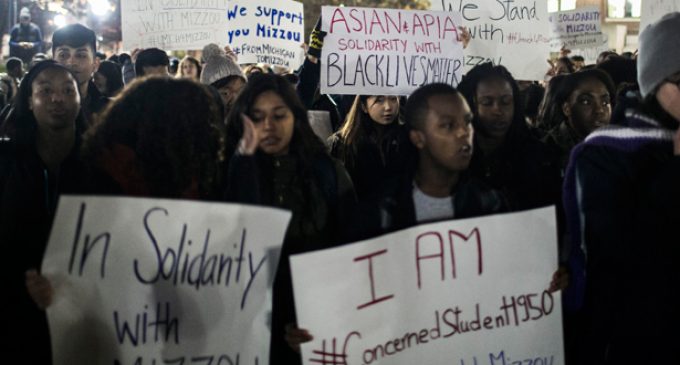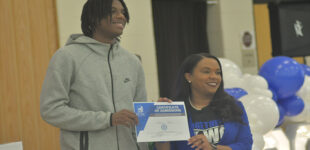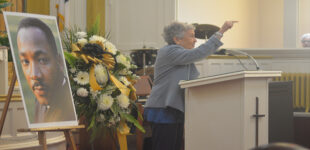Missouri campus protests illustrate new trend for college millennials

By JESSE J. HOLLAND
Associated Press
WASHINGTON–Few paid attention when a black student started a hunger strike at the University of Missouri to protest racial strife on campus. As soon as the football team supported that hunger strike by refusing to practice for or play in the school’s lucrative NCAA games, the university’s president and chancellor were forced out and changes were discussed.
The stand taken at Missouri illustrates a new trend for college millennials. Frustrated with what they perceive as insensitivity by school administrators, they are taking their generation’s penchant for social media protest to the next level: Using their on-campus celebrity to pose a threat to the bottom line.
“They forced the administration to take the protest seriously, given the money that is generated via athletics. To say that you will not play on Saturday is tantamount to a major donor pulling their funds,” said D’Andra Orey, a political science professor at Jackson State University in Jackson, Mississippi.
Students have been organizing and protesting racial strife at universities all year – from a noose being found on Duke University’s campus, to spray-painted swastikas and nooses at the State University of New York’s Purchase campus, to a fraternity video at the University of Oklahoma using a racial slur to describe how the Sigma Alpha Epsilon fraternity would never accept black members.
Last month, a popular marching band at Howard University, one of the nation’s premier historically black colleges, wore all black during a halftime football show in a show of solidarity with students frustrated about financial aid and other problems.
This week at Yale, students took to the streets after an Oct. 28 university email warning about racially insensitive Halloween costumes prompted a professor to complain that Yale and other campuses were becoming “places of censure and prohibition.”
But nowhere have students been able to force change like they have at Missouri, the state’s flagship university and a relatively new member of one of the nation’s premier football conferences, the Southeastern Conference.
The student government president reported in September that people shouted racial slurs at him from a passing pickup truck, galvanizing a weeks-long protest movement by concerned students. On Nov. 2, with little fanfare, graduate student Jonathan Butler went on a hunger strike to demand the resignation of university system President Tim Wolfe over his handling of racial complaints.
On Nov. 7, more than 30 members of the Missouri football team went on strike in support of Butler’s protest, with support from their coach.
That act got attention. A disruption of the Missouri football schedule – the Tigers play the Brigham Young Cougars in Kansas City, Missouri, on Saturday with at least two more games in the season – could have cost the school millions in revenue and penalties, not to mention negative publicity to outsiders and potential recruits.
Missouri Gov. Jay Nixon, U.S. Sen. Claire McCaskill, and other lawmakers issued statements and the national media flooded the Columbia campus. Wolfe resigned, followed hours later by the top administrator of the Columbia campus, Chancellor R. Bowen Loftin.
“It’s much easier for them to ignore students that aren’t in the public eye than for them to ignore those who are in the public eye,” said Sarah Jackson, a communications studies professor at Northeastern University.
Protests on college campuses are nothing new, even during a year marked by a nationwide debate over police brutality. Universities and colleges are used to protestors going back to the Vietnam and civil rights era, and have developed methods to deal with objections.
Institutions know they can offer to set up committees and discussion groups to bleed off the passion and publicity of student protesters with minimal changes and negative publicity. But that approach doesn’t work as well when applied to student athletes, band members and other school representatives who help bring much-needed publicity and funding to the institution.
“Universities increasingly care about the bottom line,” Jackson said. “They care about students wanting to come to their universities.”
Putting financial pressure on an organization is a tried-and-true pressure tactic, said Lonnie Bunch, director of the Smithsonian National Museum of African American History and Culture, which opens in the next year.
In the 1920s through the 1960s, civil rights organizers put together “Don’t Shop Where You Can’t Work” campaigns, organized sit-ins at lunch counters, and refused to ride in public transportation that forced blacks to sit in the back – including the famous Montgomery bus boycott. The goal was to change Americans’ hearts and minds, but also to damage the profit margin of discriminatory businesses, Bunch said.
“Hurting the financial bottom line is a long tradition,” he said.















